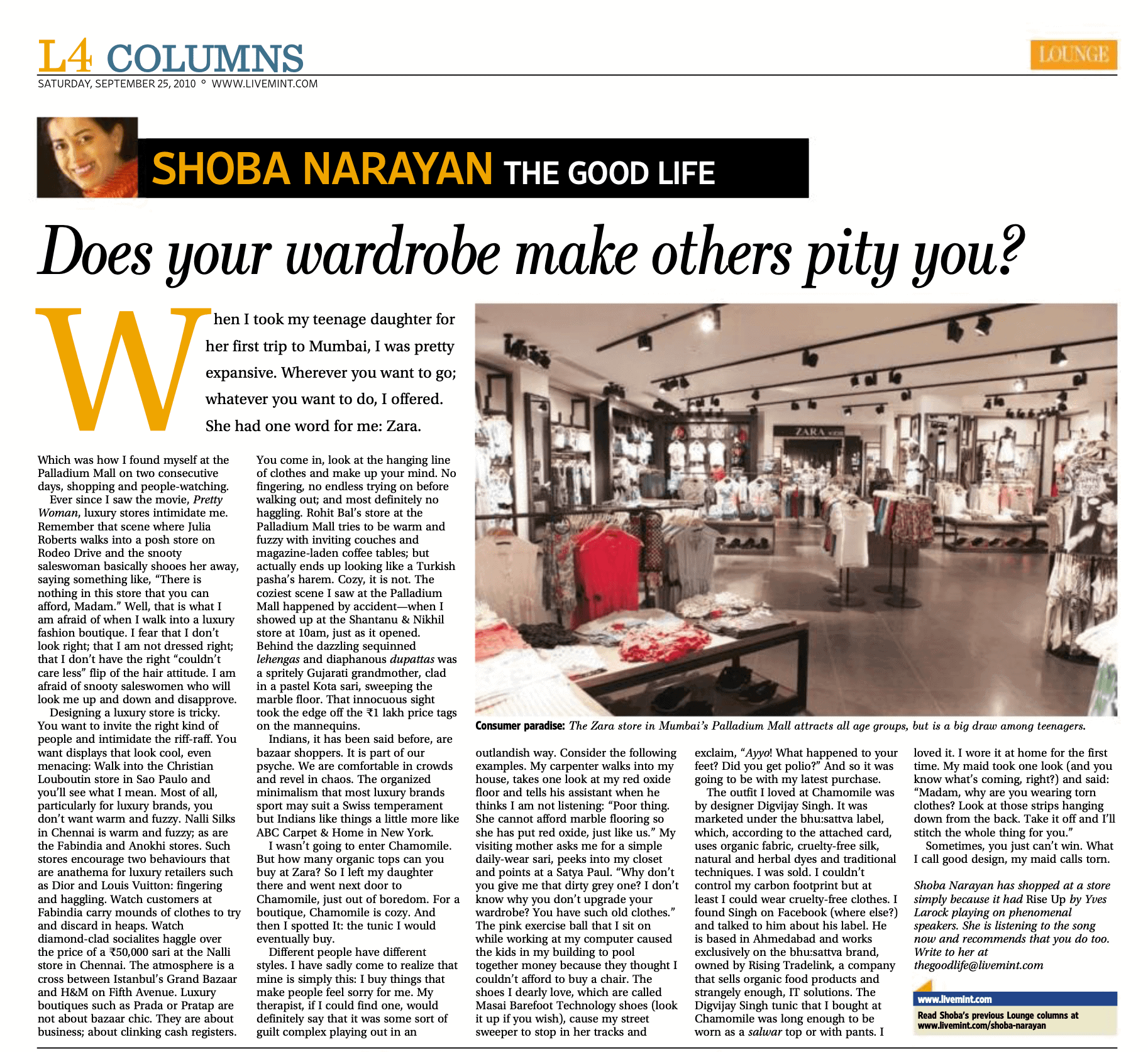When I took my teenage daughter for her first trip to Mumbai, I was pretty expansive. Wherever you want to go; whatever you want to do, I offered. She had one word for me: Zara. Which was how I found myself at the Palladium Mall on two consecutive days, shopping and people-watching.
Ever since I saw the movie, ‘Pretty Woman,’ luxury stores intimidate me. Remember that scene where Julia Roberts walks into a posh store on Rodeo Drive and the snooty saleswoman basically shooes her away, saying something like, “There is nothing in this store that you can afford, Madam.” Well, that is what I am afraid of when I walk into a luxury fashion boutique. I fear that I don’t look right; that I am not dressed right; that I don’t have the right ‘couldn’t care less’ flip of the hair attitude. I am afraid of snooty saleswomen who will look me up and down and disapprove.
Designing a luxury store is tricky. You want to invite the right kind of people and intimidate the riff-raff. You want displays that look cool, even menacing: walk into the Christian Louboutin store in Sao Paolo and you’ll see what I mean. Most of all, particularly for luxury brands, you don’t want warm and fuzzy. Nalli Silks in Chennai is warm and fuzzy; as are the FabIndia and Anokhi stores. Such stores encourage two behaviors that are anathema for luxury retailers like Dior and Louis Vuitton: fingering and haggling. Watch customers at FabIndia carry mounds of clothes to try and discard in heaps. Watch diamond-clad socialites haggle over the price of a Rs. 50,000 sari at Nalli. The atmosphere is a cross between Istanbul’s Grand Bazaar and H&M on Fifth Avenue. Luxury boutiques like Prada or Pratap are not about bazaar chic. They are about business; about clinking cash registers. You come in, look at the hanging line of clothes and make up your mind. No fingering, no endless trying on before walking out; and most definitely no haggling.
Rohit Bal’s store at the Palladium mall tries to be warm and fuzzy with inviting couches and magazine-laden coffee tables; but actually ends up looking like a Turkish pasha’s harem. Cozy, it is not. The coziest scene I saw at the Palladium mall happened by accident– when I showed up at the Shantanu & Nikhil store at 10 a.m., just when it opened. Behind the dazzling sequined lehengas and diaphonous dupattas was a spritely Gujarati grandmother, clad in a pastel kota sari, sweeping the marble floor. That innocuous sight took the edge of the Rs. 1 lakh price tags on the mannequins.
Indians, it has been said before, are bazaar shoppers. It is part of our psyche. We are comfortable in crowds and revel in chaos. The organized minimalism that most luxury brand sport may suit a Swiss temperament but Indians like things a little more like ABC Carpet & Home in New York.
I wasn’t going to enter Chamomile. But how many organic tops can you buy at Zara? So I left my daughter there and went next door to Chamomile, just out of boredom. For a boutique, Chamomile is cozy. And then I spotted It: the tunic I would eventually buy.
Different people have different styles. I have sadly come to realize that mine is simply this: I buy things that make people feel sorry for me. My therapist, if I could find one, would definitely say that it was some sort of guilt complex playing out in an outlandish way. Consider the following examples. My carpenter walks into my house, takes one look at my red oxide floor and tells his assistant when he thinks I am not listening, “Poor thing. She cannot afford marble flooring so she has put red oxide, just like us.” My visiting mother asks me for a simple daily-wear sari, peeks into my closet and points at a Satya Paul. “Why don’t you give me that dirty gray one? I don’t know why you don’t upgrade your wardrobe? You have such old clothes.” The pink exercise ball that I sit on while working at my computer caused the kids in my building to pool together money because they thought I couldn’t afford to buy a chair. The shoes I dearly love, which are called Masai Barefoot Technology shoes (look it up if you wish) causes my street sweeper to stop on her tracks and exclaim, “Ayyo! What happened to your feet? Did you get polio?” And so it was going to be with my latest purchase.
The outfit I loved at Chamomile was by designer Digvijay Singh. It was marketed under the bhu:sattva label, which, according to the attached card, used organic fabric, cruelty-free silk, natural and herbal dyes and traditional techniques. I was sold. I couldn’t control my carbon footprint but at least I could wear cruelty-free clothes. I found Digvijay Singh on Facebook (where else?) and talked to him about his label. He is based in Ahmedabad and works exclusively on the bhu:sattva brand, owned by Rising Tradelink, a company that sells organic food products and strangely enough, IT solutions. The Digvijay Singh tunic that I bought at Chamomile was long enough to be worn as a salwar top or with pants. I loved it. I wore it at home for the first time. My maid took one look (and you know what’s coming, right) and said, “Madam, why are you wearing torn clothes? Look at those strips hanging down from the back. Take it off and I’ll stitch the whole thing for you.”
Sometimes, you just can’t win. What I call good design, my maid calls torn.
Shoba Narayan has shopped at a store simply because it had “Rise Up” by Yves LaRock playing on phenomenal speakers. She is listening to the song now and recommends that you do too.
This content appeared as below.
3 min read . Updated: 23 Sep 2010, 07:59 PM IST







Leave A Comment